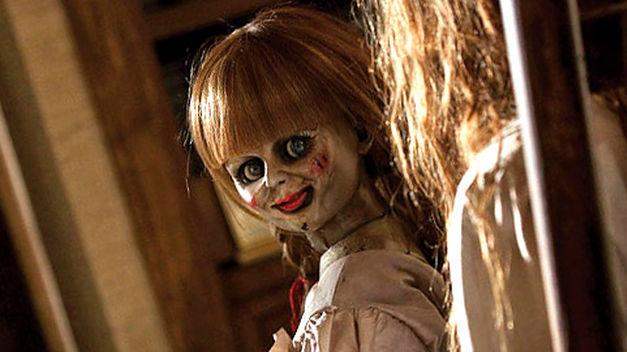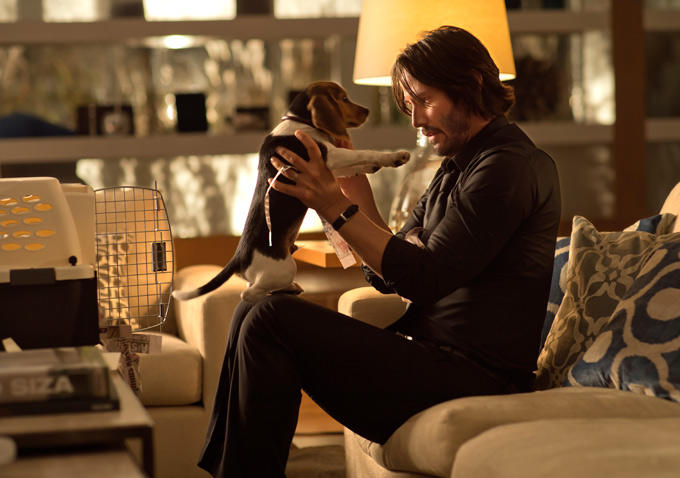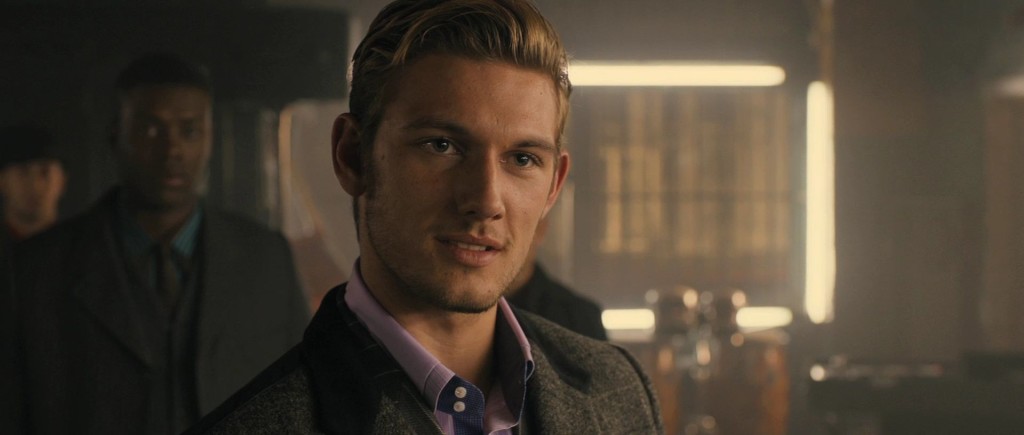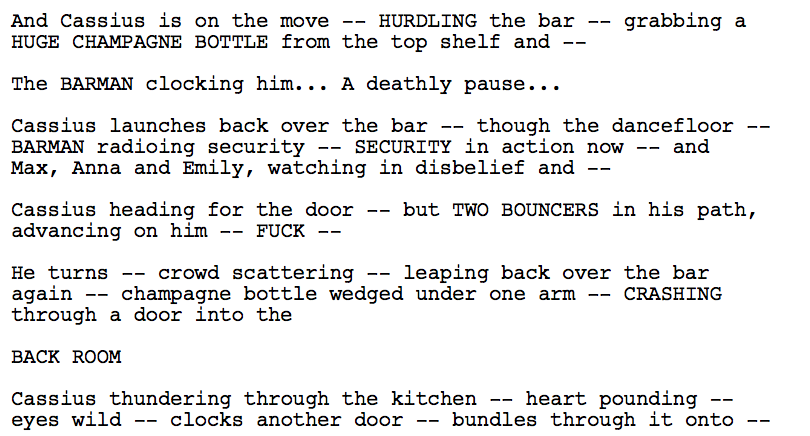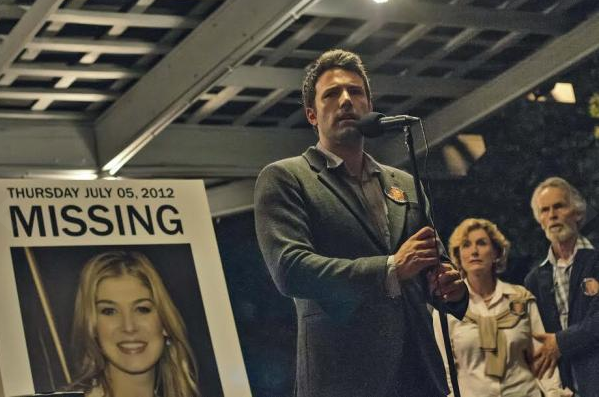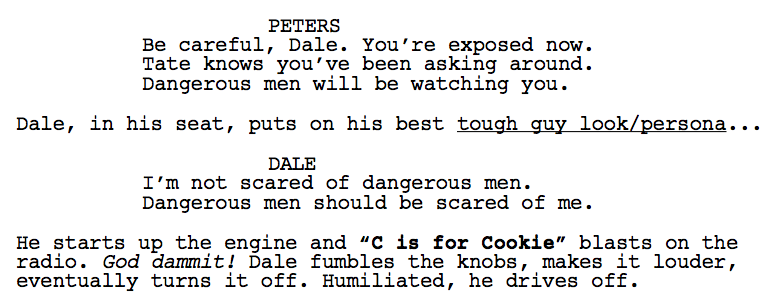It’s turned into a Mish-Mash Monday, which may sound depressing but I just couldn’t bring myself to read and review The Last Witch Hunter this evening. I’m actually having an existential crisis with this script. How do you make witches scary to grown men? I know how you make them scary to little girls. But how do you make them scary in a Vin Deisel movie? Is Vin Diesel one of the witches? That could be scary. This is the catastrophic conundrum I’m in, is that this simply doesn’t make sense, this project. It’s the reason I’ve been so on the fence about reading it. One side of me says there’s no way it could ever be any good. Another wonders, what if they’ve found an ingenious clever way to make witches badasses? And that’s why this movie is getting made? Cause they found the secret! And I’m missing out on it because I’m being a little wuss-boy who refuses to crack open a screenplay. I’ll ask you guys. Are any of you interested in this project? Does this sound like a good idea or a disaster? Because right now I’m kind of imagining this is going to look exactly like Dracula Untold (???), where they had a 25 million dollar budget but tried to make it look like they had a 125 million dollar budget? Can’t say I’m wanting to see that movie.
Speaking of movies people shouldn’t see, I saw Annabelle this weekend. You know, the horror movie with the doll? I am now convinced that there are a group of writers studios call on in Hollywood that are specifically brought in to borify a script. There have been a handful of times where I’ve walked out of a movie feeling absolutely ZERO emotion from a film, but this one trumps them all. Annabelle wins the prize for the most boring 90 minutes of story ever created. I mean the screenplay was uninspired. The casting was uninspired. The directing was uninspired. They even found a way to make that creepy-looking doll uninspired. Did you know that the doll doesn’t even move the whole movie? Like it doesn’t do anything. It just lays there? I thought this was supposed to be a movie about a scary doll. How can that happen if the DOLL ISN’T SCARY? Somebody bring back Chucky.
But I did learn something from the experience. Scary movies need to be scary. That’s not a facetious line. I know I talk a lot here about the importance of a good story and good characters with “depth” and “backstory” and “flaws.” But after watching Annabelle, I realized that none of that actually matters if you don’t put a single thought into creating good scares. There were no good scares here. NONE! In an entire horror movie. You’d think you’d get one just by accident. But this entire movie amounts to waiting for the doll to do something scary and that moment never happening.
And let me take this moment to explain, at least partly, why this was the case. “Annabelle” was following a rule-set it had established in its backstory, which is that the doll itself doesn’t become a thinking moving thing. It’s merely being manipulated by a demon that has attached itself to the doll. So the invisible demon can do things like pick it up and move it, but the doll is never going to do anything beyond that.
I HATE when writers create rule-sets that prevent their movie from becoming a better movie. If you have a rule-set you’ve established, and that rule-set prevents your world from functioning in a way that’s going to make your movie more entertaining? You have to re-think the rule-set. And that’s definitely what happened here. I’m not saying the doll had to have facial expressions. But it needed to do more than get dropped on the ground. I mean come on.
I also saw myself some “A Million Ways to Die In the West,” on Itunes, a script that I actually liked. But boy did the movie not work. I mean, Seth McFarlane, bless his heart, is not an actor. He is awkward to look at. He’s awkward to listen to. He has an awkward gait when he moves. He’s also so vain that he kept his same haircut and 2014 look despite being in a movie set in the year 1880.
But the big takeaway from the film was that McFarlane spent way too much time on the relationship. There were a half dozen scenes at least where him and the romantic interest (Charlize Theron) would go do something together that had nothing to do with the plot. For example, they’d go to the fair and just hang out there for 10 screen time minutes. What did this have to do with anything? Beats me. As you all know, every scene should push the story forward, should get your characters closer to their objectives. If that’s not happeing, you probably don’t need those scenes. And if your characters don’t have any objectives in the first place, then you have much deeper structural problems.
I call these scenes, which I see ALL THE TIME in amateur scripts, “Pause Scenes.” Because it’s literally like the writer pauses the story so his characters can engage in a scene he thinks might be cool or funny. Then, when the scene is over, he unpauses the story and we continue moving forward again. This should never be the case. The idea with screenwriting is to always combine these scenarios into one. If you want to include a fun scene, find a way to make it an essential part of the story.
So earlier in A Million Ways To Die In The West, there’s a scene where our hero has to square off against some guy he owes money to. If you really want to include the Fair scene, then make it so that our hero is supposed to meet that guy there to settle their debt. Our hero also gets dumped by his girlfriend in the first act. Maybe the Fair is his first chance to talk to her again. He’s hoping to go there and get her back. This way the scene has an actual point to it, instead of it feeling floaty and unimportant.
Finally, I caught Chef, yet another directed-written by-acted vehicle and boy did it start out great. I mean I was like, “This is that fun easy-going movie you throw on on a Saturday to feel good about life.” But that structural problem I saw in the screenplay way back in my review (we don’t get to him starting the food truck – the actual PREMISE of the movie – until after the halfway point) came back and bit this thing in the ass.
Favreau is so good with dialogue and he knows he’s so good with dialogue that he thought he could dialogue us to Marmalade Heaven and we’d forget all about the plot beats. But if we watch a movie about a famous chef who decides to start a food truck and he doesn’t actually start selling food on that food truck until the final act? We’re going to be a pretty impatient audience, aren’t we?
The big killer with the script is that Favreau gave us two of the exact same set pieces. The opening act is about him serving the biggest food critic in the city, and it turning into a disaster. So how does he follow that? By giving us THE EXACT SAME SCENE. He again prepares to serve the same food critic and it again turns into a disaster. 15 minutes were put into each sequence, totaling 30 minutes of screen time. Youch!
I heard Favreau likes to write fast and that he didn’t rewrite this too much, wanting to capture that “energy” you only get with a first draft. But there’s no doubt that a couple of rewrites would’ve caught this problem and made the script a lot better as a result. Because the truth is, we needed the hero to fall hard in those first fifteen minutes, be down on his luck for the next 12-15 minutes, and then have that Food Truck option open up. Since he’s un-hirable, he gives it a shot, and you can now focus more on the core reason we came to the movie in the first place, which is to watch this down-on-his-luck chef reinvent himself.
I was actually talking with Miss Scriptshadow about the movie afterwards because she had the same issue. “Why did it take so long to get to the truck?” I told her I’d listened to an interview with Favreau where he’d made a point to say he wanted to change up the structure because whenever he goes to a movie, he knows what’s going to happen at every stage. He wanted this movie to be unpredictable even to the more seasoned movie-goers.
“Well that’s stupid,” she replied. “So he made his movie worse just so it would be harder to predict?” It was a sound observation that brought up a deeper question. As writers, in our eternal quest to keep the audience guessing, should we make a plot beat or a character different JUST TO MAKE IT DIFFERENT? Sure, Favreau’s movie would’ve been more predictable had we gotten to the food truck sooner, but wouldn’t it have been more satisfying? Wouldn’t the story have moved along quicker and therefore kept the audience more entertained? I think so. What do you guys think?
Well, that about does it for me. I’m gonna conk out. In the meantime, I’ll dream about my new movie obsession. Star Wars 7? No. Batman vs. Superman? Not a chance. I’m talking about John F&*%ING Wick. Me and Keanu have a date for October 24th. Goddamit, that dog was a gift from his dying wife!
Who’s coming with me???
NOTE: The Scriptshadow Newsletter just went out and includes a review of that new Shark Spec that sold for almost a million bucks. Check your SPAM and PROMOTIONS tabs if it isn’t in your Inbox. If you didn’t receive the newsletter, let me know. Also, if you want to sign up for the newsletter, head on over here and send me your e-mail. Hope you guys enjoy it!
Now, on to this week’s Amateur Offerings. Read as far as you can and tell us which script you liked best in the comments!
TITLE: The Followed
GENRE: Action Thriller
LOGLINE: An amnesiac security officer must solve the mystery of the night he and his daughter went missing in order to find her before the rogue network of sophisticated criminals tracking him.
WHY YOU SHOULD READ: What I did here is set out to write a script that used the gothic surroundings of Prague as a noir character. While the thematic elements of both Bourne & Taken somewhat inspired what I did here, this is designed for an A-list actor to sink their teeth into because it’s largely the story of one man, who remains the focal point throughout, and his struggle to get his memory back and find his daughter. It’s not conventional in its approach and I’ve been told the ending is wickedly un-Hollywood. Because it’s not exactly conventional, I thought this may be a good discussion piece for the variety of writers on your site.
TITLE: The Log in Your Eye
GENRE: Dark Comedy
LOGLINE: When a pastor’s wife suspects her husband is having an affair she hires someone to follow him and find out if her suspicions are true…
WHY YOU SHOULD READ: This is a script I’ve been working on for almost five years. I have only shown it to a few friends/family so it’s hard to gauge how good (or bad) it really is. I’m hoping the ScriptShadow community can help me by giving me their expert opinion.
TITLE: Misfire
GENRE: Comedy
LOGLINE: A desperate neophyte screenwriter must do everything in his power to prevent the collapse of his first produced movie, an ill-fated Western titled “Janice Got a Gun”.
WHY YOU SHOULD READ: Do you like werewolves, zombies, aliens and found footage? Neither do I. That’s why I wrote a relatively grounded comedy that will never get made. But all of my effort won’t be in vain if you read this and enjoy some of it or even laugh once or twice. Are you an aspiring screenwriter? If you answered yes, this might just be the script for you
TITLE: Sins of The Father
GENRE: Crime/Drama
LOGLINE: An innocent assignment leads a young man on an investigation in which he ultimately discovers the awful truth of his father’s hidden past.
WHY YOU SHOULD READ: Reminiscent of Mississippi Burning the story takes place in the deep South in the early sixties when social change was in the air. Except, in one small town controlled by a Wealthy Cotton Mill owner with an insidious past. Carl Henderson was not only a Bigot but a War Criminal serving in the German Army as an SS Commandant in a concentration camp. His son Todd, doing an innocent college assignment, unwittingly discovers this truth, but in doing so completely destroys his family.
TITLE: Judgement
GENRE: psychological thriller/drama
LOGLINE: A grief-stricken doctor must decide whether to seek the ultimate vengeance, and kill the man that murdered his family
WHY YOU SHOULD READ: I had just read a newspaper article about a home invasion, where two scumbags murdered just “for fun”, just to see what it felt like. My response to this was pretty visceral, so I wanted to get it down on paper. One of my favorite ways to tease/pitch the script is to pose this scenario: “Imagine the worst physical thing that could happen to a human…now imagine rooting for it to happen”.
Get Your Script Reviewed On Scriptshadow!: To submit your script for an Amateur Review, send in a PDF of your script, along with the title, genre, logline, and finally, something interesting about yourself and/or your script that you’d like us to post along with the script if reviewed. Use my submission address please: Carsonreeves3@gmail.com. Remember that your script will be posted. If you’re nervous about the effects of a bad review, feel free to use an alias name and/or title. It’s a good idea to resubmit every couple of weeks so your submission stays near the top.
Genre: Crime/Drama
Premise (from writer): Having been kidnapped in South Africa, a resilient young traveller is forced into criminal activity by his captors in order to repay the ransom his family could not afford.
Why You Should Read (from writer): I got notes for this [from Carson] about a year or two back. Following some rewrites, it’s had a couple of producers on and off the project, getting closer each time. I’m looking to find out why this script hasn’t gone beyond getting interest into getting made.
Writer: Ned Kilgannon
Details: 112 pages
Today’s writer, Ned, asks a great question. A question that thousands of Hollywood insiders and outsiders ask all the time. Why hasn’t my project, which has gotten interest from a lot of people, been able to take that next step and get made?
It’s a frustrating question for people particularly because they see so many bad movies getting made. And then they have their project, which they think is pretty darn good, and for some reason it can’t cross the finish line.
Well, I have some theories about this, which I’ll be glad to share in a second. But before I do that, let’s take a look at the script at the center of our question… Devil In You.
22 year-old Cassius Ramsey is just another spoiled rich kid who’s got money to burn. He chooses to use that money to roam the earth while he figures out what to do with his life. His travel partner, Max, may not have the same deep pockets as Cassius, but he’s got the same spirit for adventure.
Somewhat bored with the typical touristy places kids travel to, the duo decide to check out South Africa, thinking they’ll have a more “original” experience. But as soon as they land, they notice some sketchy men targeting them. Then, on the bus ride out of the airport, they’re stopped and kidnapped by a ruthless gang of criminals.
When the criminals find out Max’s family is penniless, they kill him. But the criminals’ kidnapping-for-cash job doesn’t go as planned when Cassius’s estranged father tells the kidnappers to fuck off. Facing death himself, Cassius pleads with the crew to let him join them. He promises he’ll pull his weight.
The intimidating but pragmatic leader, Jacques, gives Cassius a test to rob a local woman, and he passes with flying colors. Soon, Cassius finds himself moving up the gang’s ladder as he excels at every job and continues to impress Jacques. There’s something exciting about this life that plays to Cassius’s sense-of-adventure. But at a certain point, he starts to yearn for home again, and ultimately must decide whether he wants this life, or his old one.
Before I can answer Ned’s question, I first want to provide what, in my opinion, are the four types of ways movies get made.
The first tier are the sure-things. These are the projects that are so good, either through concept or execution, that nothing can stop them from getting made. These are the Jurassic Parks, the Hangovers, the Transformers, the American Beautys. Everyone knew these movies were going to get made as soon as they heard the concept or read the script. These projects are forces of nature. Nothing can stop them.
The second tier are the studio mandated movies, the ones that are created solely because the studio believes they’ll make money. These are typically spearheaded by producers who don’t really care about the quality of movies so much as what they do to their bottom-line, and the results reflect that. Sometimes you get your Sex Tapes and sometimes you get your Snow White and the Huntsmans. Somteimes you get your Blendeds and sometimes you get your Lego Movies.
The third tier are the writer-directors out there who have the power to make films just on their name. This is actually where a lot of the bad movies – the ones where you wonder “How the hell did that get made?” – come from. There are no checks and balances on these scripts since the writer-director can make whatever they want. And while sometimes that can be a good thing. Other times it can be a disaster. Sofia Coppola’s “Somewhere.” Jason Reitman’s “Labor Day.” These are Tier 3 films.
The fourth and final tier is where everyone else lives. The rest of the projects get made through good old fashioned passion. Because think about it. Nobody wants to make any movies outside of the first three tiers. Therefore, the only way to get a movie made is if you cheerlead your project into existence, if you send it out to everyone, if you push it through wall after wall, if you pester anyone you know to read it, no matter how uncomfortable that pestering becomes.
A movie like The King’s Speech is a perfect example. Nobody wanted to make that movie. Seidler sent it everywhere. Thinking Geoffrey Rush would be the perfect actor for the part of the teacher, he went through his agent. The agent told him to fuck off, that Rush would never have any interest in the part. So Seidler actually found out where Rush lived and sent it there. Rush read it and loved it. Seidler’s passion for his material got the movie made.
Here’s the thing with passion though. People don’t get passionate about shit. You can try using a bunch of smoke and mirrors but if your script’s bad, no amount of cheerleading’s going to get you followers. So having success in the fourth tier usually dictates a minimum amount of quality. The higher the quality your script is, then, the more likely your passion will catch on with others, and the easier it will be to get your script through the system.
Which brings us back to Devil In You. Devil in You, I believe, meets the minimum level of quality required for a Tier 4 project. It’s a solid script, in the vein of movies like Goodfellas and The Godfather, about a guy moving up inside a crime organization, with a unique spin in that it’s set in South Africa and has an unlikely hero.
So why isn’t it a sure thing yet? My feeling is that it’s not big enough. If you look at films like The Godfather and Goodfellas, you got the feeling that our characters were moving up higher and higher into a bigger and bigger world. Just the other day I was talking about how you never want the word “small” in your logline. Nobody makes a movie about “small.” And yet that’s how this feels to me. It’s a relatively small gang and it never grows. With some minor exceptions near the end, I never felt like the crimes they pulled got any bigger, any badder. Cassius definitely moves up within the gang, but I’m not sure that matters if the gang’s influence within the community itself doesn’t grow.
Also, I didn’t really know where the script was going. It didn’t seem to be driving towards that big climax. Again, it felt stagnant, like the gang was just going from one average robbery to the next. For example, your typical heist movie will have the “big last heist.” So we have something to look forward to. Or if you don’t have that, then you at least have to have the feeling that things are getting bigger and that they’re coming to a head. Like I was saying the other day, you need to feel like the balloon’s blowing up. I’m not sure I ever felt that here.
So if I were advising Ned on this particular project – helping him find a way to get this made, I’d tell him to think bigger. Have this gang grow more with each robbery. Just like all these crime movies, show Cassius move his way up the ladder until he’s a serious badass. I guess that’s another problem I had. I never saw Cassius as anything other than that traveller. I never saw him truly lose himself in this world. And I think that’s because Ned was constantly pumping the breaks.
As far as some personal opinions, I’d make Jessica Jacque’s girlfriend, and have her and Cassius have to sneak around. I’d also ditch the Robin Hood stuff. If we’re going to make these guys bad, let’s make them bad. Let’s have Cassius truly have to cross over into a brutal world. True, the Robin Hood stuff makes Jacques and his outfit more interesting, but I think it limits the gang in how far they can go. That’s how I’d attack it if I were him.
So to summarize, the less impressive the script is, the more passion will be needed to get it made. You can either try to supply that passion yourself and be the biggest cheerleader in the world, or you can get back to work on the script and let it do the work for you. I think Ned’s a really good writer. I just think this script needs to feel bigger. It needs to build more. What do you guys think?
Script link: Devil In You
[ ] what the hell did I just read?
[x] wasn’t for me
[ ] worth the read
[ ] impressive
[ ] genius
What I learned 1: It’s hard to cast 20-somethings (especially early 20-somethings) to carry a movie. Studios are reluctant to do it unless it’s a high school or college film. It’s not that it’s never done, but in genres like crime, they typically like someone older.
What I learned 2: You want to make your writing easy on the eyes. You want to make it a pleasing read. The excessive use of dashes and capitals made for a harder read than usual here. As someone who had just read two really easy-to-read scripts, this stuck out. Here’s a sample of what I mean. This hurt my eyes.
1) Start with a better opening scene – Your opening scene is everything, not just because it kick-starts your story, but because it’s when you’re being judged the harshest. The battle between writer and reader is usually won or lost early on. So don’t give us some “decent” opening scene. Whether you’re writing a blockbuster or an introspective indie film, start us out with something that catches our attention immediately.
2) Cut out excess description – Too much description slows down the read, which creates the illusion that the story itself is slowing down. The key is to always stay on point. Any line that isn’t describing an action or an important piece of information can probably go. This is especially important during the climax, when the script must move the quickest. I’ve read two scripts in the last month which were ruined by over-described climaxes.
3) Get your hero out on his/her journey by page 25 – Whatever his ultimate goal is in the movie, have him start pursuing that no later than 25. Readers have less and less patience these days and if your script is wandering during the very first act, it’s an indication it will only get worse later.
4) Cut out your three worst scenes – If those scenes have important information in them, figure out a way to move that information to other scenes.
5) Give us at least one weird memorable character – Have at least one character in your script who’s unique, different and unforgettable, the kind of character you know actors will be climbing over each other to play. The autistic hitman (The Accountant with Ben Affleck – coming soon), the goofball pirate (Pirates of the Caribbean), the polite serial killer (Silence of the Lambs), the sex-crazed obese woman (Bridesmaids), the manic-depressive romantic (Eternal Sunshine). The reality is, movies get remembered, but characters get immortalized. If you can’t give us at least one unique stand-out character, you’re not writing a complete script.
6) Make sure your characters are talking to each other, not the audience – In other words, stop making your exposition so obvious. Exposition is born mostly out of characters talking directly to the audience. If it ever sounds like you’re doing that, rewrite the scene and focus on what the character would REALLY SAY (like IN THE REAL WORLD) to the other character in the scene. See if you can slip your exposition into that conversation.
7) Eliminate all on-the-nose dialogue – Always try to have something going on underneath the scene when two characters are talking. It doesn’t have to be a giant secret. It could be that one person is simply aggravated with the other. But if your characters are constantly saying exactly what they feel, what they want, what they’re thinking, and there’s no hidden agenda or hidden thoughts behind those words, then your dialogue is likely on the nose.
8) Set up several big questions throughout your script which you don’t answer right away – These will act as suspense-threads, which, if the questions are compelling enough, will keep the reader reading until they get the answer. Questions can range from, “What happened to Amy?” (Gone Girl), “Why do I keep waking up over and over again on the same day?” (Edge of Tomorrow), and even smaller stuff, like “Whose baby is this?” (The Hangover).
9) Focus more on character – One of the biggest problems I’ve been seeing with scripts lately is that the writers always focus on plot. Plot is the mechanics of the story. They’re the things that happen to, for, and against your characters. But remember, the audience connects with the characters, not the story. So figure out what your hero is battling (flaws, vices), what the problems are between each set of people in your story (distance, lack of trust), and focus more on those. An exclusively plotty story gets very boring if you don’t put in the character work.
10) Add more conflict/tension to your scenes – Go through all your scenes. There should only be a few where everything is going swimmingly. For the rest, make sure there’s some kind of conflict or tension taking place. The scene in Gone Girl where Nick calls over the cops after Amy goes missing is a great example. Although they’re having a perfectly cordial conversation, the tension comes in the fact that the cop is suspicious of Nick. She’s wondering if he had something to do with this. One of the quickest ways to bore me as a reader is to give me scene after scene where characters are happy and/or agreeable.
Genre: Drama
Premise: (from Black List) Based on a true story, Dale Julin (a low-level Fresno affiliate morning show host) stumbles upon the biggest story of his life – and though he has reached the midpoint of his career without ever being a “real journalist” – risks his safety and his marriage to uncover the truth that a small Atomic bomb exploded in Central Valley California during the Korean War – a secret that had been hidden for decades.
About: I decided to go BACK to the Black List for today’s script. “Time and Temperature” finished on the low end of the list with 7 votes. The writer, Nick Santora, is a big deal in the TV world. He’s written for The Sopranos, Law & Order, Prison Break, and most recently created the CBS show, Scorpion. Santora did something I’ve claimed on this site is impossible. He won a screenplay contest (the New York International Film Festival Screenplay Contest) with his FIRST screenplay. Off that win, he was hired to write an episode of The Sopranos. Please don’t throw your laptops against the wall. Time and Temperature will be Santora’s directing debut. Ivan Reitman is producing the film.
Writer: Nick Santora
Details: 120 pages (5/31/13 draft)
On Monday we were talking about what makes an idea big enough to be a movie. In this day and age, unless you’re specifically aiming for the indie market and an Itunes release, you have to think big. And when I read the premise for this on the Black List, all I could think was, that doesn’t sound big enough to be a movie.
First of all, you have the word “small” in your logline. That’s not a good word to have in any logline. Movies are supposed to be big. The events that happen within them need to feel huge (unless you’re going for that indie market). Who cares about a “small atomic bomb?” It sounds insignificant in the grand scheme of things.
Tack onto that the Korean War. The Korean War?? The Korean War is like the forgotten stepchild of the Vietnam War. Nobody remembers the Korean War. Already this is looking bad. I mean, if you told me this was about a Japanese-American journalist in 1945 who found out that the U.S. was going to drop an atomic bomb on Hiroshima 2 days ahead of time and he had to decide whether to report about it or not… now you have yourselves a story. A mini-atomic bomb that didn’t even get dropped on anyone 60 years ago? Is that really a movie? I pray it is. Or else these are going to be a looooong 120 pages.
Time and Temperature is set in 1989 and focuses on local news show host Dale Julin. Dale’s specialty is doing those fluff-pieces like testing out the local Clown School. Which, in a way, is appropriate, since Dale’s career so far can be described as one giant pie in the face. He’s 44 years old, the age most people settle down into who they are. But Dale’s just not satisfied. He wants something more.
That opportunity presents itself when he takes his wife and two daughters to see his dad at the Travis Air Force base, where Dale grew up. His dad was a war hero, which is like adding flashing lights to Dale’s failures. While home, he learns that an old friend’s daughter just died of a rare form of cancer. But the kicker is that the man’s niece died from the same type of cancer two years ago.
His journalistic instincts kicking in, Dale starts asking around, and learns that dozens of people on the base have gotten cancer over the years. And it all came after a 1950 B-2 Bomber, which was headed to Korea to drop bombs, crashed on take-off. Dale gets the idea that this plane was carrying something with more kick than your average bomb, and he wants to prove it.
So he concocts a pretend reason to interview everyone on the base (a birthday bit for his dad) and just keeps digging. Like any good investigation story, there are some false leads, some interesting twists, and a lot of hardship, such as Dale losing touch with his family along the way. But he continues to hold onto the idea that it’s true, and that the government has been covering it up for 40 years.
It turns out there’s more to this story than just the bomb, and it’s something I wish they would’ve included in the logline (although that logline needs a meat cleaver chopping as it is). It’s not just the bomb that’s the issue. It’s that the bomb’s detonation has caused many people living on Travis Base to contract cancer.
In that sense, it’s kind of like Erin Brockovich, and it makes the story better because nobody gives a shit if a bomb blew up 60 years ago. But if people are still suffering NOW because of this? If it’s affecting the PRESENT? Now you have a story. And that’s something I wish Time and Temperature had hit on more. Because in the end, your story always has to deal with the now. Even the great The Girl With The Dragon Tattoo (the book), about a 50 year old missing girl case, ended its story here, in the now, with its main characters in trouble.
All in all, Time and Temperature was a strange read. The story doesn’t get started (Dale first finds out about the cancer) until page 38. Before that, I had no idea where it was going. All we needed were a few scenes to establish that Dale was unhappy and unappreciated at his job, and we could’ve headed off to the Air Force Base. Instead, we have way too many scenes at work covering the same thing and then him going up to a Giants game where an earthquake occurs (which he reports on). And while it was a good scene, it had me scratching my head. Why are we here? Where is this script going?
This is something we’re told over and over again but we writers are so freaking stubborn, we continue to ignore it. We fall in love with our scenes so much that we will add 5 pages of prep, 8 pages for the scene, and 5 pages of transition back to the original story JUST SO WE CAN GET THAT SCENE IN. That’s 18 pages you just wrote so you could get a single scene in. No wonder this script clocks in at 120 pages. Screenwriting is about eliminating anything that doesn’t keep the story moving forward. A trip to a Giants game moved this sideways.
But once we got to the actual investigation, the script picked up. And I started to understand Santora’s vision better. He was going for something different, a little quirkier than your average investigation story. For example, in one scene, when he’s rushing to interview a top Air Force general, Dale forgets his bag of clothes. Which is really bad because he’s still dressed in a Santa Clause suit from a just-finished news bit. I can already imagine the shot of that interview in the trailer.
Then there’s another scenario where he rendezvous with a mysterious figure in an abandoned parking lot. It’s very film noir. Unfortunately, it was Dale’s turn with the baby that day, so he’s actually wearing a baby bjorn, with a baby in it. “Is that a… baby bjorn?” the shadowy figures asks. The scene ends on the perfect note too, when the man, Peters, warns him about what’s coming…
The Black List loves this kind of stuff, where you’re riding the line between drama and humor. If you want to end up on the list, an unpredictable balance between these two will help.
Santora also does a good job with our hero, Dale. I think it’s always important to give your characters a “thing.” It doesn’t have to be a flaw, but there should be something specific that defines them. Dale is defined as “the person everyone forgets.” That point is hit on over and over again. And it’s the reason Dale’s so driven. He wants to be remembered for something. When you don’t define your characters with that specific trait, that’s when you’ll get the note from readers: “I never got a sense of that character.”
This just happened to me in a consult script I was reading. The main character was defined, but the three other family members were not, and it was very frustrating because despite each of them having a lot of screen time, I had to profess to the writer that I didn’t really know any of them.
Anyway, Time and Temperature was an up and down experience that was more good than bad. If Santora has some directing talent, he very well could turn this into a movie to watch for. It has just enough of a unique voice to distinguish it from all the other stuff out there.
[ ] what the hell did I just read?
[ ] wasn’t for me
[x] worth the read
[ ] impressive
[ ] genius
What I learned 1: Hurt other people with your hero’s actions, making it tougher for your hero to keep going. Dale’s Dad informs Dale that because of his snooping around the base, he’s about to be kicked out of his home. Now Dale’s decision to move forward is much tougher, as it’s not just hurting himself. It’s hurting someone he loves.
What I learned 2: Screen time does not define characters for an audience. You can’t just put a character in a movie for 70 minutes and assume that because they’re in it for so long, the audience will just “get” them. It’s up to you to clarify who your character is to the audience. Santora must’ve hit on the fact that Nick was a forgotten man a dozen times (when he walked into a library he was in the day before, the librarian couldn’t remember his face). So decide what that thing is that defines your character and then hit on it repeatedly through action and dialogue.

